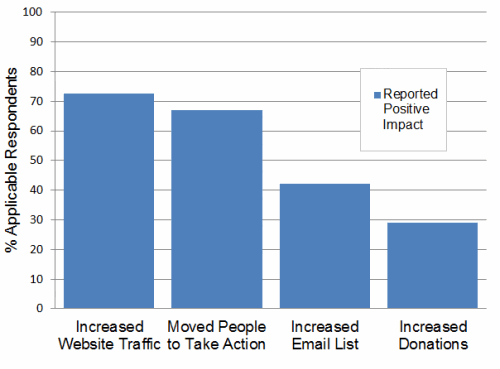
Upcoming Idealware report shows Facebook helps with event attendance, membership, volunteerism & even fundraising
Guest post by Kyle Andrei
Idealware
Which nonprofits are seeing success with their Facebook Page? In February Idealware distributed a survey (through an informal email outreach) to more than 500 nonprofit professionals who were using Facebook at their organizations. Well, the data is back, and we thought we’d share some of our most important findings.
How successful are nonprofits in attracting new constituents? We asked survey respondents whether or not they felt they had attracted new constituents (donors, members, volunteers, clients or event attendees) through their Facebook page. And people did indeed see successful results.
At top are the percentage of respondents who who said they they’d seen “a few” or “substantial” new constituents, resulting in a positive impact.
Nonprofit reps felt that Facebook was working best for them in attracting event attendees. Given Facebook’s Events app, this information isn’t terribly surprising. It’s a simple matter to create your event on Facebook, distribute it to your fans and let them distribute the invitation to their friends.
People didn’t see as much success with new donors and volunteers, though. Why is that? Are Facebook relationships too casual to warrant giving time or money to an organization? Or are potential donors or volunteers not on Facebook in the same numbers?
In addition to constituent impact, we also asked respondents about what we call “measured results” — those goals that don’t directly involve constituents and can be easily quantified. These included website traffic, donations, email list size and moving people to take advocacy actions.

Above are the percentage of respondents who said they they’d seen “some” or “substantial” effect that they would attribute to Facebook. The percentage of “Moved People to Take Action” and “Increased Donations” are out of those organization that said those actions were important to them, while “Increased Website Traffic” and “Increased Donation” are based on all respondents.
Respondents reported the most success with using Facebook to direct new people to their websites, with more than 75 percent saying they’ve seen an increase in web traffic. With free web analytics tools like Google Analytics, tracking who followed your link from your Facebook Page is one of the most measurable goals included in this survey.
And more than 65% said that they’d had some success with moving people to take some form of action for a cause, like signing petitions or other advocacy actions. Online petitions and other political or advocacy actions are easy to do, demand little time, and are easily spread through Facebook and other social media.
Following in suit from the constituent impact, donations saw little success; less than 30% saw success. Surprisingly, respondents didn’t have a huge amount of success with increasing their email lists via Facebook either — only 42% saw results. Maybe people aren’t including links or widgets to allow their fans to sign up, or like one person mentioned, fans may prefer to be contacted through Facebook messages and updates, instead of through email.
We’re continuing to analyze the data and we’re conducting a series of interviews to round them out. Stay tuned for more information and a free research report from Idealware in May.









Hopefully my experience might add value to the whole Facebook-not-generating-email-leads thing.
Regarding the person who preferred being contacted via facebook messages than email–I think this will become increasingly common, especially among young people. Some people get hundreds of emails each day, and email sign-ups are no good if they don't get opened.
At the nonprofit I work for, we've got maybe 2,700 emails in our list but consistently we only see around 462 opens for each monthly newsletter (our Facebook profile has just under 300 friends). We take this to mean that for 2,200 people it either goes to their Junk Folder or they get so many emails a day that they don't take the time to read ours. Either way, I don't fret about email address count because I know a Facebook friend is just as valuable. I'm not just making that up, either–the metrics prove it. Facebook is consistently in our top three referring sites for website traffic and usually when we post a Facebook update we see a bigger spike in site traffic than when we send out an e-blast. We also see much better click-through conversion rate for our Facebook friends than we do for our e-news signups. So if anything, a Facebook friend is more valuable to us than an email.
We're probably going to move to Pulse (http://www.bigtimedesign.ca/pulse/) before the end of the year. Basically, the move stems from this belief (rooted in stats like the one cited above) that what matters is subscription–the channel, be it Facebook, email, Twitter, etc. is irrelevant; the constituent is all we count regardless of which channel they prefer to communicate with us. It saves us from spamming the same person with the same message three or four times. Plus, it offers some useful analytics.
Full disclosure: I know a guy who works at Pulse (actually he might be the owner, I'm not totally sure–I only met him the once but we've emailed a couple times). I'm not trying to plug the service and I don't really care if you sign up for it. But I figured I'd disclose this information for transparency's sake.